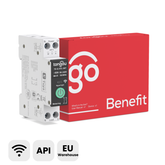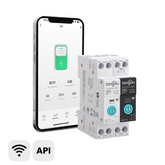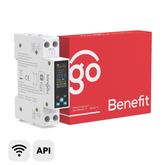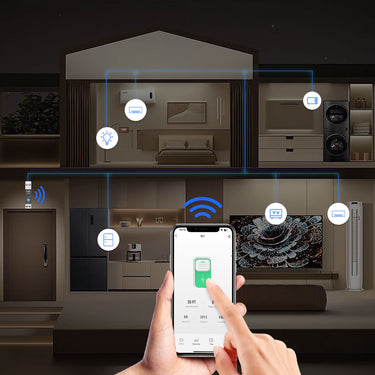Purchase Guide| 16A vs 20A Circuit Breaker: Making the Smart Choice for You
Planning a home renovation? Upgrading your electrical panel? Or simply confused about why your circuit breaker keeps tripping? You're not alone. Choosing the right electrical components is crucial for the safety and functionality of your European home. One of the most common points of confusion is selecting the correct circuit breaker amperage – particularly deciding between 16A and 20A MCBs (Miniature Circuit Breakers).
 Furthermore, with the rise of smart homes, another question emerges: should you upgrade to smart circuit breakers or smart switches?
Furthermore, with the rise of smart homes, another question emerges: should you upgrade to smart circuit breakers or smart switches?
This guide is here to demystify these choices. We'll break down the differences between 16A and 20A breakers in a European context, explain the exciting benefits of smart electrical devices, and help you confidently buy the right circuit breaker online for your specific needs. Whether you're a seasoned DIYer or just starting, understanding these basics is key to a safer, more efficient, and potentially smarter home.
What is a Circuit Breaker (MCB) and Why Does Amperage Matter?
Think of a Miniature Circuit Breaker (MCB) as the silent guardian of your electrical circuits. Its primary job is crucial: to automatically interrupt the flow of electricity when it detects an overcurrent – either an overload (too many devices drawing power) or a short circuit (a dangerous fault). This protects your wiring from overheating, preventing potential fires, and safeguarding your valuable appliances.
The amperage (A) rating on a circuit breaker tells you the maximum amount of electrical current it can safely handle before it "trips" (cuts off the power). Matching the breaker's amperage rating to the circuit's wiring capacity and the expected electrical load is non-negotiable for safety.
-
Too low an amperage: The breaker will trip frequently and unnecessarily, causing inconvenience.
-
Too high an amperage: This is extremely dangerous. The breaker won't trip when it should, allowing the circuit wiring to overheat, potentially melting insulation and causing a fire.
Understanding this fundamental principle is key before deciding between 16A and 20A.
16A vs 20A Circuit Breakers: The Common European Scenario
In Europe, electrical standards and common practices guide the typical use cases for 16A and 20A breakers. While local regulations can vary slightly (always good to check!), here’s a general overview:
16A Circuit Breakers: The Standard Workhorse
-
Typical Uses: 16A MCBs are arguably the most common type found in European homes. They are typically used for:
-
General lighting circuits.
-
Standard power outlet circuits (sockets) serving everyday appliances like TVs, computers, chargers, lamps, small kitchen gadgets (mixers, toasters), vacuum cleaners, etc.
-
Circuits where the total simultaneous power draw isn't expected to be excessively high.
-
-
Considerations: Most standard household wiring for outlets and lighting in many European countries is designed to work safely with a 16A breaker.
-
Keywords Focus: If you need protection for regular rooms and standard appliances, you'll likely be looking to buy a 16A MCB.
 Tongou Smart Circuit Breaker 1A-63A Adjustable
Tongou Smart Circuit Breaker 1A-63A Adjustable
20A Circuit Breakers: Handling Higher Loads
-
Typical Uses: 20A MCBs are reserved for circuits that need to handle a higher electrical load. Common applications include:
-
Dedicated circuits for high-power appliances: Electric ovens, certain hobs (cooktops), washing machines, dryers, dishwashers, powerful electric heaters, or instant water heaters often require their own 20A circuit.
-
Kitchen circuits with multiple high-draw appliances potentially running simultaneously.
-
Workshop or garage outlets powering tools.
-
In some specific regions or newer installations, general socket circuits might be rated for 20A (requiring appropriate wiring).
-
-
Considerations: A 20A breaker must be installed on a circuit with wiring specifically rated to handle 20 amps (typically a thicker gauge wire, like 2.5mm² or more, depending on installation method and local code). Using a 20A breaker on wiring designed for 16A is a serious fire hazard.
-
Keywords Focus: For circuits powering heavy-duty appliances or demanding higher capacity, you need to purchase a 20A circuit breaker.
The Golden Rule: How to Choose Correctly
-
Check Existing Breakers: For replacements, check the amperage rating of the breaker currently installed on that circuit.
-
Identify the Circuit's Purpose: Is it for general lighting/outlets or a specific high-power appliance? Check the appliance's power rating (in Watts or Amps).
-
Know Your Wiring: This is the most critical step. The wire gauge (thickness) determines the maximum safe amperage. Standard lighting circuits often use 1.5mm² wire (typically suited for 10A or maybe 16A depending on codes/length/installation), while standard socket circuits often use 2.5mm² (typically suited for 16A or 20A).
-
CRUCIAL SAFETY WARNING: Never simply replace a 16A breaker with a 20A breaker thinking it will solve tripping issues. If a 16A breaker trips frequently, it's doing its job – indicating an overload or fault. Replacing it with a 20A breaker without ensuring the wiring is rated for 20A bypasses this safety mechanism and creates a significant risk of fire.
-
When in Doubt, Consult an Expert: Electrical systems are complex and potentially dangerous. If you have any uncertainty about the correct amperage or your wiring's capacity, always consult a qualified and licensed electrician. They can assess your specific situation and ensure compliance with local European regulations.
Enter the Smart Era: Smart Circuit Breakers & Smart Switches
Beyond just protection, modern technology offers enhanced control and monitoring through smart circuit breakers and smart switches. What are they?
-
Smart Circuit Breakers (Smart MCBs): These devices often look similar to standard MCBs and fit onto the DIN rail in your consumer unit (fuse box). However, they have built-in connectivity (usually WiFi). This allows you to monitor the circuit, switch it on/off remotely via a smartphone app (like the Tongou Smart app), set schedules, and sometimes even monitor energy consumption. They provide both protection and smart control in one unit.
-
Smart Switches (DIN Rail Type): Similar in form factor to breakers, these might not offer the overcurrent protection of an MCB but provide smart control (On/Off, scheduling, energy monitoring) for an entire circuit controlled from the consumer unit. They are often used in conjunction with a standard MCB for protection.
-
(Other Smart Switches): Note there are also in-wall smart switches (replacing light switches) and smart plugs, but here we focus on panel-level control relevant to breaker choices.

Why Go Smart? The Benefits of Upgrading
Integrating smart technology into your electrical panel isn't just a gimmick; it offers tangible advantages:
-
Unmatched Convenience:
-
Remote Control: Forgot to turn off the heater or outdoor lights? Switch them off from anywhere using your smartphone. Turn circuits on remotely before you arrive home.
-
Voice Control: Integrate with systems like Alexa or Google Assistant (check compatibility) for hands-free operation. "Hey Google, turn off the garage circuit."
-
-
Energy Monitoring & Potential Savings:
-
Track Consumption: Many smart breakers/switches (like select Tongou Smart models) allow you to see exactly how much energy a specific circuit is using in real-time or historically.
-
Identify Waste: Discover energy-hungry appliances or circuits left on unnecessarily.
-
Informed Decisions: Use data to adjust habits, potentially lowering your electricity bills.
-
-
Enhanced Safety & Peace of Mind:
-
Remote Status Check: Check if crucial circuits (like freezers or servers) are on or off while you're away.
-
Overload Notifications (on some models): Get alerts on your phone if a circuit trips or experiences issues.
-
Scheduled Shutdown: Automatically turn off potentially hazardous appliances (like space heaters or irons) after a set time.
-
-
Automation & Scheduling:
-
Set Timers: Schedule lights, pumps, or heaters to turn on and off automatically, simulating presence or optimizing energy use.
-
Scene Integration: Include circuits in smart home routines (e.g., a "Good Night" scene could turn off all non-essential lights and outlets).
-
Making the Right Choice: Combining Amperage and Smart Features
So, how do you decide? Follow these steps:
-
Determine the Correct Amperage (Safety First!): Based on the circuit's load and wiring (as discussed in the 16A vs 20A section), decide if you need a 16A or 20A rated device. This is the primary and most important decision.
-
Consider the Need for Smart Features: For the specific circuit in question, would remote control, energy monitoring, or scheduling add significant value?
-
High-Power Appliances (likely 20A): Smart control offers safety (remote shutoff) and energy monitoring benefits. A smart 20A MCB could be ideal.
-
General Outlets (likely 16A): Monitor overall room consumption, remotely control groups of devices, schedule lamps. A smart 16A MCB or DIN smart switch paired with a 16A MCB works well.
-
Lighting Circuits (likely 16A or 10A): Excellent for scheduling, remote control, and integration into smart scenes. A smart 16A MCB or DIN smart switch is suitable.
-
Critical Circuits (e.g., Freezer, Router): While smart control is possible, ensure the device is reliable. Sometimes basic protection (standard MCB) is preferred here unless monitoring is the primary goal.
-
Why Choose Tongou Smart for Your Upgrade?
At Tongou Smart (www.tongousmart.com), we specialize in providing reliable, user-friendly smart electrical solutions designed for modern European homes. Our products offer:
-
Reliable Protection: Meeting essential safety standards.
-
Easy Smart Integration: User-friendly app control, scheduling, and often energy monitoring features.
-
Quality Build: Designed for durability and performance within your consumer unit.
-
Wide Selection: Find the right amperage and smart features for your specific needs.
Your Next Steps: Shop Smart, Stay Safe
Choosing the right circuit breaker – whether a standard 16A, a higher-capacity 20A, or an advanced smart option – is fundamental to your home's electrical safety and functionality. Remember to always prioritize matching the breaker amperage to your wiring and load.












